 The life and history of several European countries in the 17th century were connected and, thus, their fashion trends were similar. France, England, and Spain. All of them were powerful colonizers and wealthy states in Europe. And fashion always is influenced by politics, culture, and lifestyle of a certain period. So, what did the European aristocracy wear in the 1600s and why? What silhouette, hairstyle, and clothing pieces were the most fashionable? And how did the 17th-century fashion influence our modern clothes and style?
The life and history of several European countries in the 17th century were connected and, thus, their fashion trends were similar. France, England, and Spain. All of them were powerful colonizers and wealthy states in Europe. And fashion always is influenced by politics, culture, and lifestyle of a certain period. So, what did the European aristocracy wear in the 1600s and why? What silhouette, hairstyle, and clothing pieces were the most fashionable? And how did the 17th-century fashion influence our modern clothes and style?
The article is based on a video by Amanda Hallay, fashion historian
France
It’s Louis who's the real King of Fashion.
As a consequence, female attire in the 17th century is far less elaborate and far less decorative than male attire.
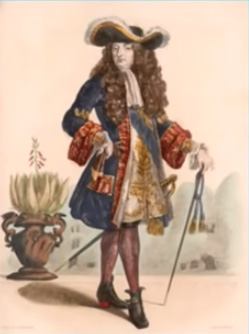
Louis XIV set strict rules for court dress. Although nobody was allowed to dress more extravagantly than he was, his rules were almost the opposite to The Sumptuary Laws of the Middle Ages and the Renaissance. Louis’ rules were that every nobleman must wear a certain and specific set of very expensive clothes for every individual occasion. And this included their wives, of course.
If nobles weren't wearing the right set of clothes, they weren't allowed to the Court. And they had to be at the Court, they had to be close to Louis because, otherwise, they would lose power and prestige.
Some of the French nobility actually went bankrupt trying to keep up with the King’s fashion rules. But this is where he was so clever – he'd lend you money for your clothes, for your wardrobe. And this would put you forever in his debt. It means that he had robbed you of your power but could rely upon your support.
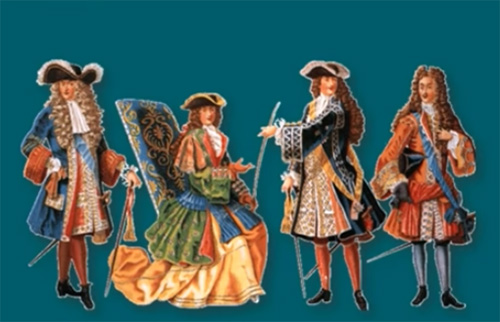
And that’s how clothing and fashion were used to a political extent in the 1600s, like never before or ever since.
Louis also made it illegal for nearly everything that makes up clothing to be imported. As a consequence, France became the world’s largest and best producers of lace (the town of Chantilly was particularly good at it, hence “Chantilly lace”). This employed thousands of people, and it boosted France’s economy, particularly its exports.
He also mandated that the streets of Paris be lit up at night to promote late-night shopping.
In short, Louis XIV invented “the fashion industry” as we know it. And forever secured Paris as the international capital of fashion.
Women
As we’ve already mentioned, women were less decorative. But the silhouette did change a little from the earlier part of the 1600s. Because of a “basque”. It laced at the back and it had a very long point at the front, so it was kind of like a corset. It gave women a higher waist and this pointed front.
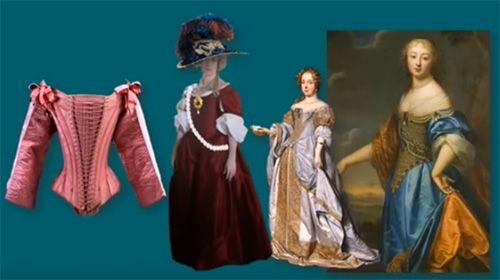
It also had the scooped neck, the slope shoulders, and the billowy sleeves.
And really, it wasn't adorned all that much. There was a trend to wear a string of pearls diagonally over your body (kind of like a baldric on a man) and a brooch at the front.
Hats imitated male hats. And male hats at this point became extremely large, extremely decorative, with a lot of ostrich feathers.
The shoes. Mules were the preferred shoes of the nobility during the High Baroque period. Basically, the mules are backless high-heeled shoes.
Men
It was really men who strutted their stuff as the peacocks of the High Baroque era.
Let’s see what garments did males wear.

A heavily trimmed hat.
A periwig.
A cravat or jabot, which is a lacy kind of flap at the front of your collar.
Brocade vests replaced doublets.
A billowy shirt with lace sleeves and lace cuffs.
A ribbon loop trim. It was the trim of choice in the 1600s. They are ribbons, looped and then sewn together.
Then, petticoat breeches.
Finally, lace cannons and high-heeled shoes. Take a look at these vintage shoes. These are men's shoes.
And capes covered it all.
On the right, is a surviving outfit.
During this era, mustaches were rather popular.
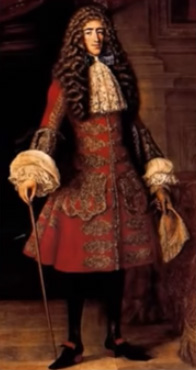
Another important item from this period is called a “justaucorps”. It was a coat that was used for riding primarily. A justaucorps is a flared, fitted jacket with slits at the front, side, and back for horse riding.
Periwigs
The word “periwig” comes from the French “perruque”, which means “wig”. Today, we usually drop the “peri” and use the word “wig”.
It was Louis XIV who started the fashion of using wigs. Because Louis started to go bald. You can tell in this painting that he's already thinning a bit on top.
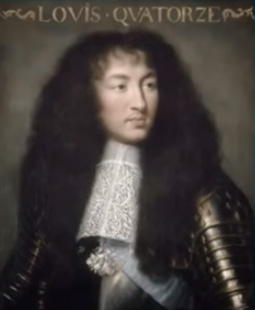
Louis was such a fashionista, so you can imagine how much he hated being bold. And he started wearing these long, gorgeous, voluminous, curly wigs. And, of course, because Louis wore them, everybody had to wear them. And everybody did.
It was practical because there was an awful lot of lice around in the 1600s. So men would cut their hair short or shave their heads completely and wear a wig. Wigs would stay in fashion for the next 150 years.
There is an expression from that era: “keep your hair on”, meaning “don’t lose your temper”. It comes from the men in Parliament during the 1600s or 1700s. When they were losing their temper, they were taking their wigs off and throwing them across the room.
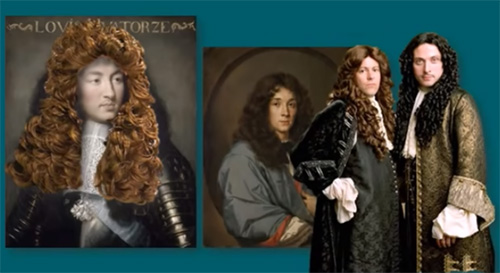
The quality of the wig in the 1600s-1700s depended on what you could afford, just like today. The best works were made out of human hair, obviously. If you couldn't afford human hair, you could use horse hair. There was no synthetic hair at that time but you could use horse hair or maybe goat hair, but the aristocracy all had human hair. And ordinary people would sell their hair.
By the end of the 1600s, wigs became powdered. During the mid-1600s, they were dark, because Louis XIV was dark and so was Prince Charles II. Later in the 1600s and throughout the 1700s, wigs were powdered white or gray-white.
Children
Basically, children dressed like their parents. Such a tendency can be seen throughout the 1700s and most of the 1800s. Only in the Victorian era (1837-1901), appears the notion of children's wear.
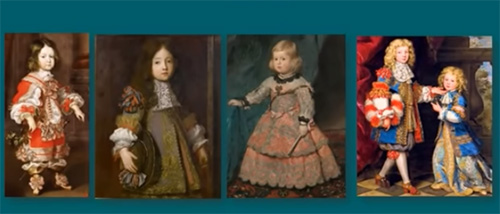
Spain
Costume of the Spanish Court in the 1600s
Something really strange was happening with fashion in the Spanish Court. These incredibly wide skirts were constructed with something called a “panniers”. Later, the panniers and this silhouette became fashionable throughout Europe, but at this point, it was only the Spanish Court that used them.
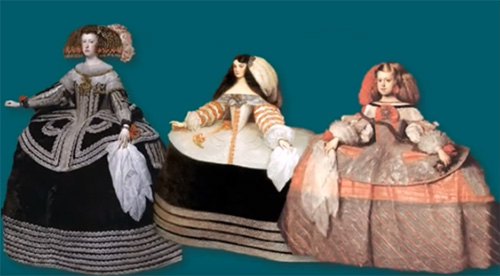
Also, look at the hairstyles. This is Queen Anna Maria of Spain, wife of Philip II. And in this picture, she has a very extraordinary hairdo made with wigs or hairpieces. But why did women wear their hair like this?
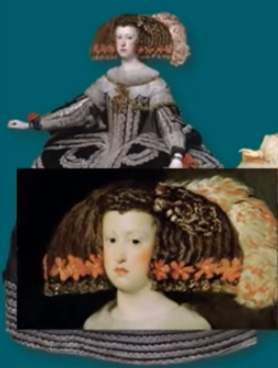
What was happening in Spain in the 1600s? This was all about their conquest of the Americas. They have destroyed the Aztec civilization, they have destroyed the Incas in Peru. Spain ruled that part of the world, and their whole court fashion was an expression of this. The expanse of their skirts symbolizes the expanse of the Spanish Empire. And their hairstyles did, too. These hairdos remind of an Aztec crown, they have the same shape. These hairstyles were a pretty literal demonstration that the Spanish had “stolen the crown” from the Aztecs and the Incas.
England
The Restoration
At the same time in England, there had been 11 years of the Commonwealth, 11 years of Cromwell (English military and political leader who served as Lord Protector of the Commonwealth of England, Scotland, and Ireland from 1653 until his death, acting simultaneously as head of state and head of government of the new republic).
This was a time of no music, no parties, no fashion…
After Oliver Cromwell’s death, after almost 11 years of his rule, the English wanted a king again. So Prince Charles II came out of exile, where he'd been living with his cousin at Versailles, and in 1660, he was crowned. This period until his death in 1685 is known as The Restoration.
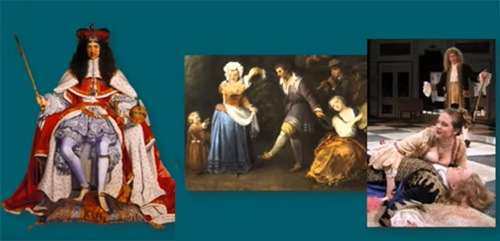
King Charles was known as “The Merry Monarch”. He was very smart. He came back to a country that had been so fed up with no fun that he put fun right back on the agenda. This was a pretty sexy time after such an uptight Puritan decade.
Women
And fashion responded. Here is a series of images, all from a famous painter of The Restoration Peter Lely.
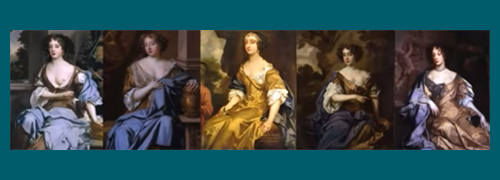
You can see in one of the paintings the breast of a woman. Of course, this was just for a dramatic effect, she didn't go around with her breast showing. But all of these females look a little bit disheveled. And these beautiful loose-fitting taffeta dresses kind of falling off their shoulders. Their hair a little bit askew. The whole idea was to look a little bit intentionally disheveled, relaxed, and as if you had just been tumbling around in a bed with someone.
The hair was wide at the sides and, again, with these disheveled ringlets.
And if to talk about the fashionable colors of The Restoration period, they are gold and blue – the colors that Cromwell disliked the most.
Men
Charles II was beloved, but he was mindful of the role that an excessive interest in fashion had played in his dad's demise. There were many people in the country still who didn't want a king. There were many parliamentarians who did not believe that he should be there at all. So Charles prudently issued a decree to all the gentlemen of the court, laying down very strict rules about dress.
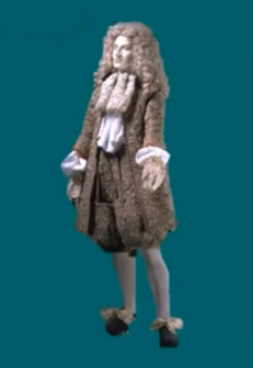
During his rule, the male nobility were commanded to wear a longish jacket, breeches, a shirt, and a cravat or a jabot. Only those 4 items + their hat and shoes. This was to give the illusion that everybody was being sensible and thrifty. It was the rule and everybody had to follow it.
Shirt, suit, and tie. That idea wouldn't last long, would it? But it became an absolute staple, and it started in The Restoration, it started with Charles II.
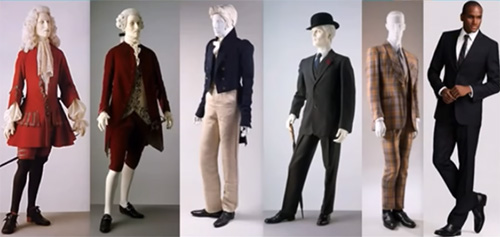
Women after The Restoration
Because of this new silhouette for men throughout Europe, female attire began to echo this new, very vertical, male silhouette. In The Restoration period, female costume was very wide and billowy – this changed. Suddenly, the silhouette became vertical.
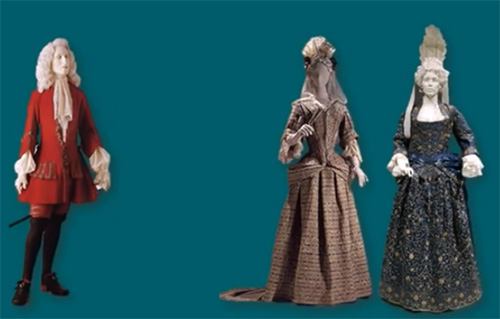
This type of dress is called a “mantua”. And this hairdo, with the wired fabric headdress, is called a “fontange”. It's very elegant and it just adds to the vertical silhouette.
Another item of clothing in this new silhouette is a hunting dress and jacket. It's a skirt and jacket and a shirt. This outfit imitated the male attire (on the left). And this is really the first time such a thing happens.
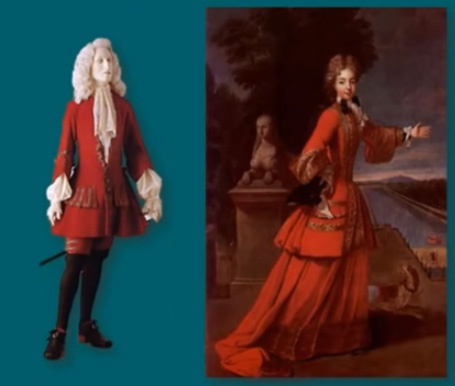
(c)


